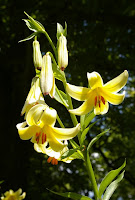Graham Rice was one of the judges of the competition for new plants, and he has written about them and the show in more detail in his blog Transatlantic Plantsman. This post therefore reflects my thoughts as an outsider to the mainstream horticultural industry. I should say first, however, that because the lighting in the hall made photography very difficult, I obtained a set of images of plant entries from the HTA Press Office for use here - I am very grateful to them for this, and point out that the copyright remains theirs. The poorer pics are mine.
This was not the sort of horticultural show I usually go to, with specialist nurseries selling their plants to a discerning public. This was about the mass market, the garden centre and big store trade, where the vast majority of plant sales take place. It was about the future impulse purchase, and the emphasis is on novelty and presentation: horticultural bling. There is of course nothing wrong with this, quite the contrary, but the contrast with the specialist nurseries is extreme. It is very salutary for one who mostly lives in the world of specialist horticulture to come down to the reality of garden centres, and to be reminded of the network of breeders, growers, producers and retailers who put the majority of plants into the majority of gardens. The show was for everyone from the producers of bedding plant plugs to suppliers of large potted specimens from Italy, specialist conifer nurseries to Dutch lorry traders. It made for a vibrant occasion.
Begonia 'Glowing Embers'
What of the plants? The majority on display were the standard range offered, from alpines to trees, all well grown and crisply presented, but the exhibition provided a great opportunity to show off the latest introductions either on the grower's stand or as part of the competition for new introductions. Winners in the different categories of the competition are listed here. The Best in Show, and Best Annual awards both went, thoroughly deservingly , to Begonia 'Glowing Embers' shown by its distributors Allensmore Nurseries. It is a stunning plant (the HTA pic above does not do it justice), with dark (but lighter-veined) foliage and nice single, smallish orange flowers. I look forward to growing it.
Defining novelty is never easy. Those in the competition were suposed to have been introduced this year, and no doubt they were, but one often has to look very carefully to perceive differences in new cultivars of, for example, Heuchera and Nemesia (there were several entries from both). Of the latter I liked two from Farplants, 'Framboise' and 'Mirabelle' (illustrated right). Heuchera on the other hand exemplifies what I call the 'anything but green' syndrome of the horticultural trade - the predominance of coloured foliage to catch the eye of the impulse buyer. Coloured foliage is no bad thing in itself, when judiciously used, but its preponderance in some displays - and by extension, in some gardens - is overdone. The winner of Best Shrub was an 'ABG' plant, Coprosma 'Tequila Sunrise' (from New Place Nurseries and Woods Nurseries) with dense, multi-coloured swirls of glossy foliage. It clearly has a potential place in the garden, and I can imagine it being particularly useful in winter.
Coprosma 'Tequila Sunrise'
Of the other entries I liked the look of Sambucus 'Black Tower' (yes, an ABG! ), a fastigiate Elder from Seoint Nurseries with broad, very glossy black leaflets, but hope that its green growing tip is a result of the conditions the plants were grown in, as it is a little disconcerting. There were several interesting daisies in the Hardy Nursery stock category. Leucanthemum 'Real Galaxy' , with a tutu of yellow rays around a broad disc is quite nice, and also from Farplants is the Atlas Series of Rhodanthemum cultivars. As exhibited these were not looking their best, but I thought that 'Casablanca' (below, left) with white flowers over silver foliage has some real promise as a rock plant. The Garvinea Series of Gerbera (Bell Brothers Nurseries Ltd) (below, right) are attractive, and claimed to be hardy - but I am wary of such claims!
Among the very many good plants in the hall one really interested me - a hybrid Eucomis from the Dutch supplier Javado. Labelled Aloha Lily 'Leia', it has soft purple flowers on a short plant, with green, slightly wavy-edged and spotted leaves. These characters, and its not very pleasant fragrance, immediately suggest to me that it is a hybrid between E. zambesiaca and E. vandermerwei, but where my such seedlings are dull and brownish, the breeder of 'Leia' has achieved a very pleasing colour. Several bulbs together in a pot make a fine sight - unfortunately the picture is not so good.
Eucomis 'Leia'
[I must confess to borrowing the phrase 'anything but green' from the title of an American publication that ran for several years but is now defunct, catering to the interests of the lovers of variegated plants]










































































